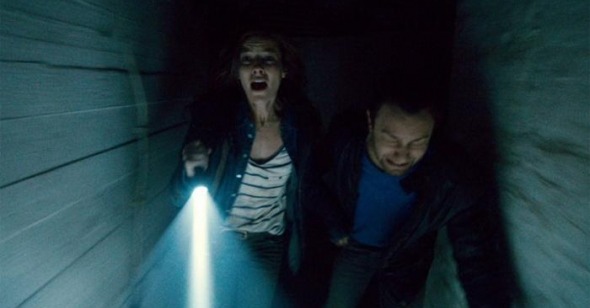Scare Tactics
by Kiva Reardon
Chernobyl Diaries
Dir. Bradley Parker, U.S., Warner Bros.
If Eduardo Sanchez and Daniel Myrick’s The Blair Witch Project caused the ascendance of found-footage horror films, then we could credit Paranormal Activity writer-director-producer Oren Peli with bringing them to a saturation point. While the popularity of a film often speaks to tapping into a cultural zeitgeist, Peli’s creation seems less motivated by modern political and intellectual climates but instead by the effective deployment of base-line scare tactics: watching a Paranormal Activity is akin to walking through a fairground’s haunted house, waiting to be spooked as you round every corner—the lowest common denominator of fear. Chernobyl Diaries, a mutant monster tale that Peli wrote and produced, similarly relies on this repeated manipulation of the senses. This is not to devalue visceral reactions to cinema but to suggest that sometimes, as in this case, they are unearned. Peli’s films function like patellar tap tests, proving that our nervous systems are in order but saying nothing of our cognitive abilities.
Unlike Paranormal Activity, Chernobyl Diaries does not center on a found-footage premise. Directed by Bradley Parker, the film follows a group of young Americans who, on a tour of Eastern Europe, decide to take a side trip to Pripyat, Ukraine, the site of the Chernobyl disaster. When their van breaks down they become stranded, and humanoid monsters—the townspeople affected by the radiation, in the vein of The Hills Have Eyes—pick them off one by one. The most monstrous beings, however, appear in the film’s final (and highly predictable) twist, as evil doctors who have hidden the existence of the mutants for years.
Though his film follows a conventional narrative, it would seem Peli cannot resist incorporating found footage, using it to introduce his characters and again, predictably, for a kill sequence. We begin with camcorder footage of irksome, upper-class American youths gallivanting about Europe, striking gauche poses in front of Lonely Planet guide stop-points, as if checking off items on a “How to Experience Europe” list. The introduction leads us to believe this will be another camcorder-POV film, but as the credits finish the camera pulls out of an iPad screen held by one of the characters. While cameras make repeated appearances, constantly drawing our attention to the notion of filming, it is to no thematic end, as Chernobyl isn’t remarking on our cultural reliance on or acceptance of recording devices; the constant visual references merely allow viewers to congratulate themselves on noting the meta-cinematic gesture. This is unfortunate, for when the found-footage aesthetic is applied with an ounce of intelligence—as in Eduardo Sanchez’s recent film, Lovely Molly, where the killer is the one wielding the camera—it taps into the horror of not merely being watched but being recorded. Here, however, it remains a gimmick, and it’s already become a tired one.
Following the credits, the film begins in Kiev, Ukraine. Chris (Jesse McCartney), along with his girlfriend Natalie (Olivia Dudley) and her friend Amanda (Devin Kelley), have gone to meet his brother, Paul (Jonathan Sadowski), who has been living abroad, sowing his seed amidst the wild Eastern European women. In a brotherly confession scene meant to establish their strained yet loving relationship, Chris reveals their next stop is Moscow, where he will propose to Natalie. While the home-video set-up of the first Paranormal Activity, which Peli wrote, was often improvised, here there is less room for ad-libbing, and the strain on Peli to write an actual script begins to show. For Peli striving for verisimilitude seems to amount to continually using the word “bro” and later when under duress, repeating expletives in between lines of overused clichés” (“We’re going to get out of here!”). Despite this, Sadowski plays it straight, portraying an efficient yet fundamentally naïve seducer. Sadowski’s allure isn’t merely sexual but charismatic—a crucial point as it makes his ability to sell to his friends the idea of a day trip to Chernobyl believable.
The choice to set the remainder of the film in Pripyat could have resulted in something evocative, since enough time has passed that for some (the presumed teenage and twentysomething audience for the film) the Chernobyl disaster is no longer a tragedy but merely a name, a place of mutant lore. The film both recognizes and exploits this, and this is where it is most honest. Chernobyl Diaries isn’t exploring the complexities of fear—it wants to incite a reaction. As the film is being positioned as an Oren Peli product, it is not surprising that Chernobyl Diaries accomplishes the task of making the audience jump. A good horror film, however, burrows into your skin, staying there long after the conclusion. These scares remain superficial; once the credits roll, the fear fades. And by no coincidence, so does the film.
